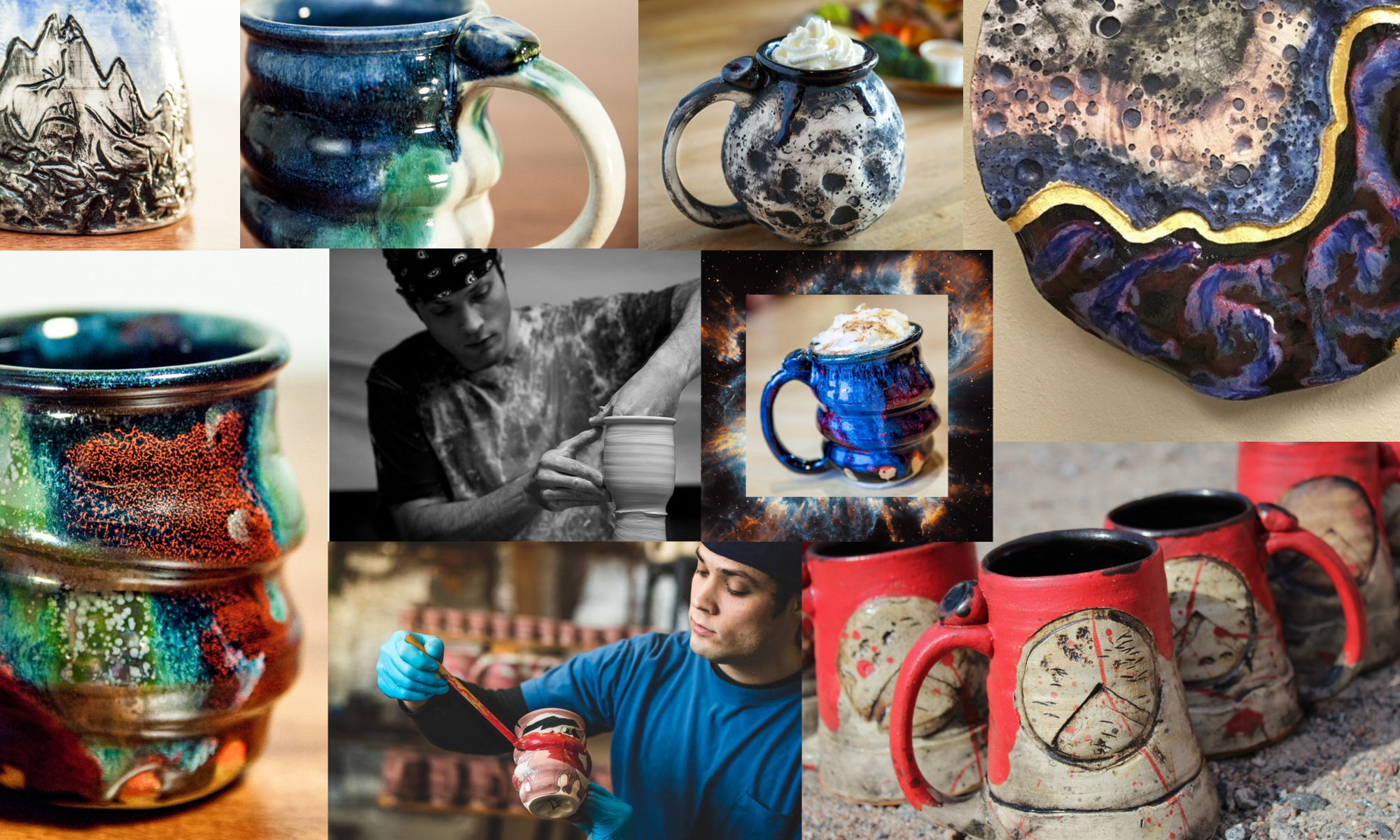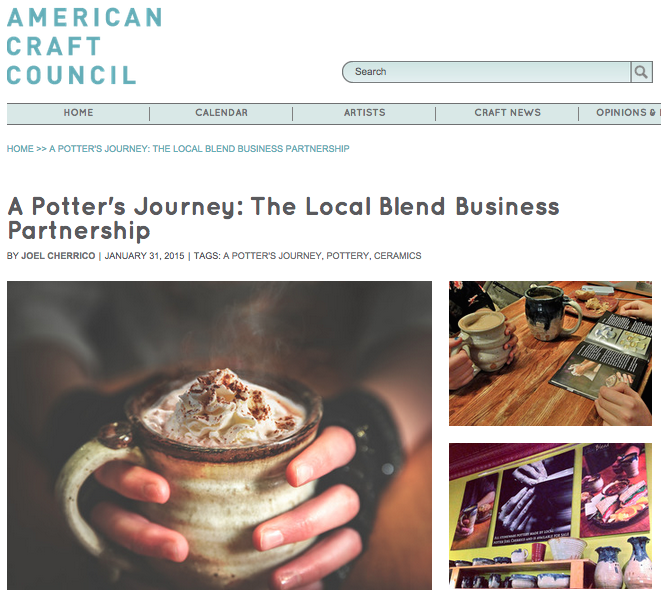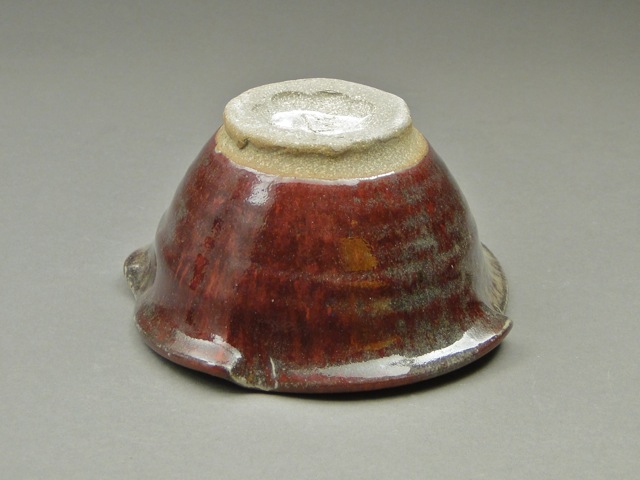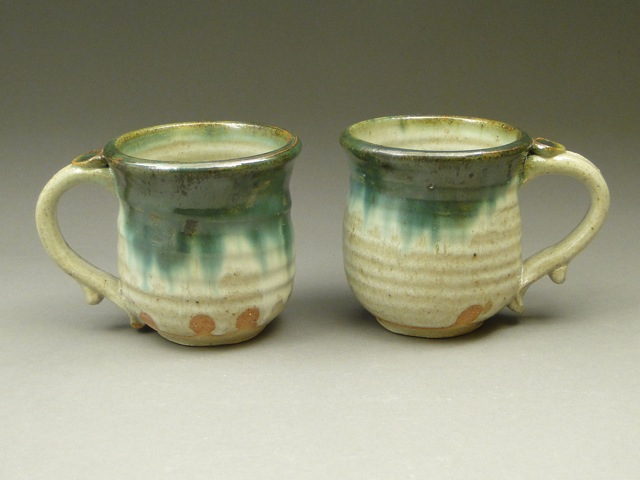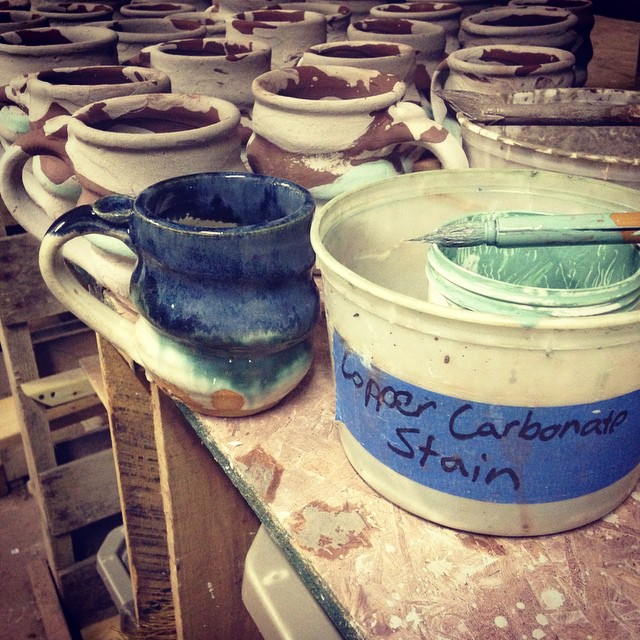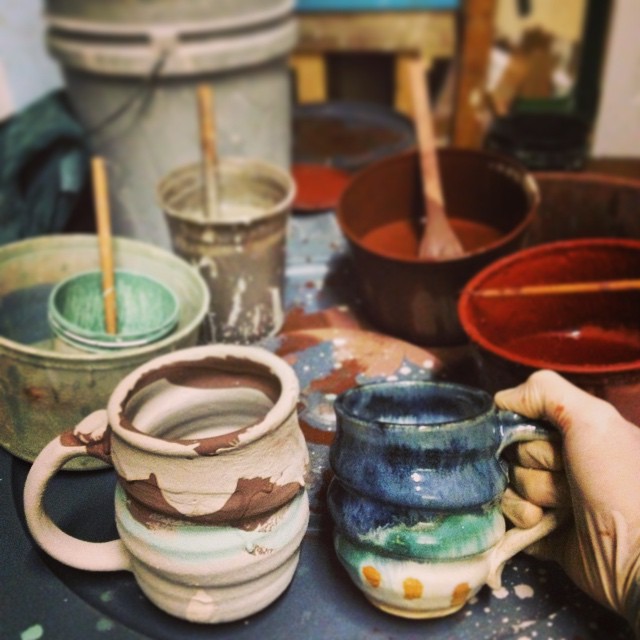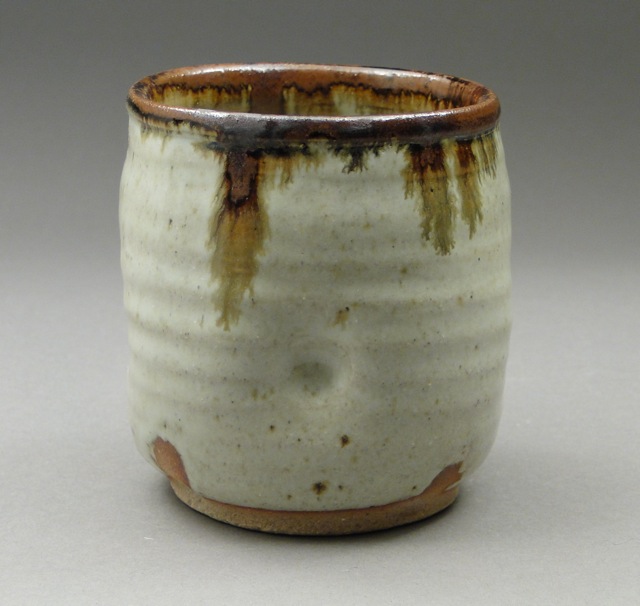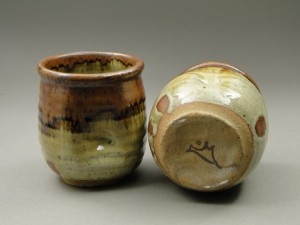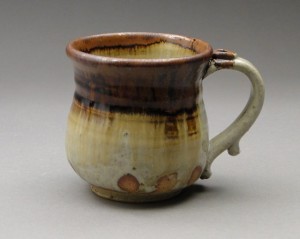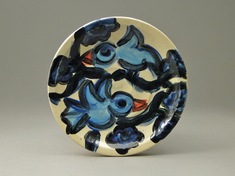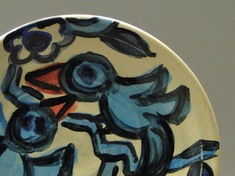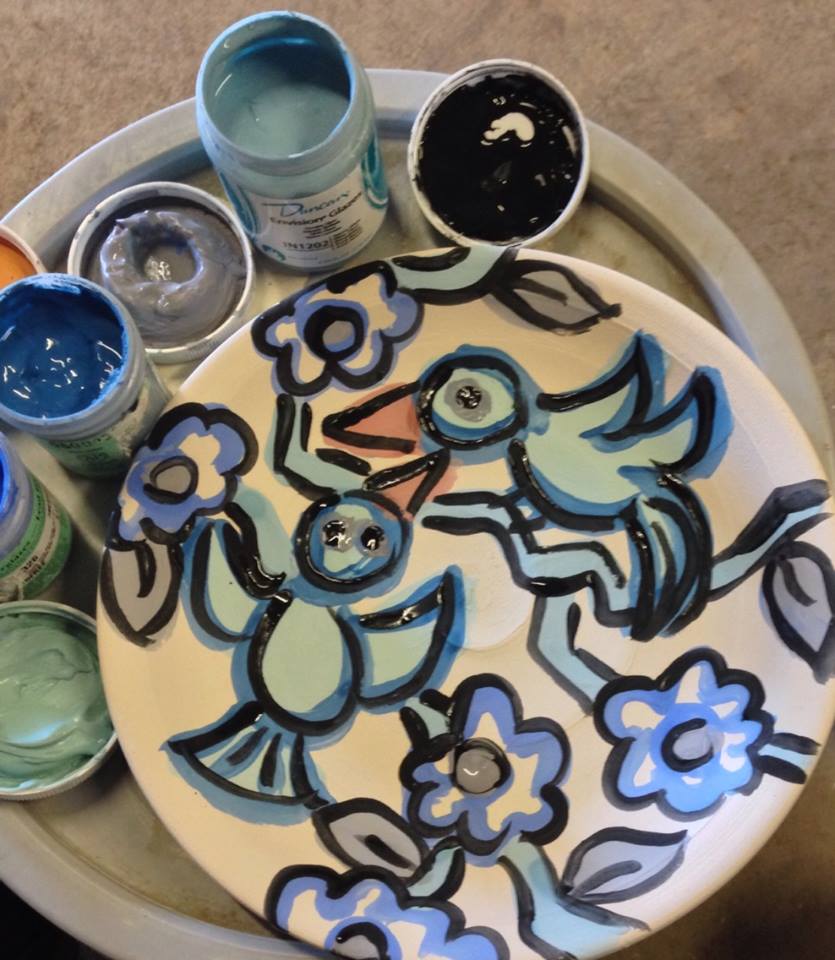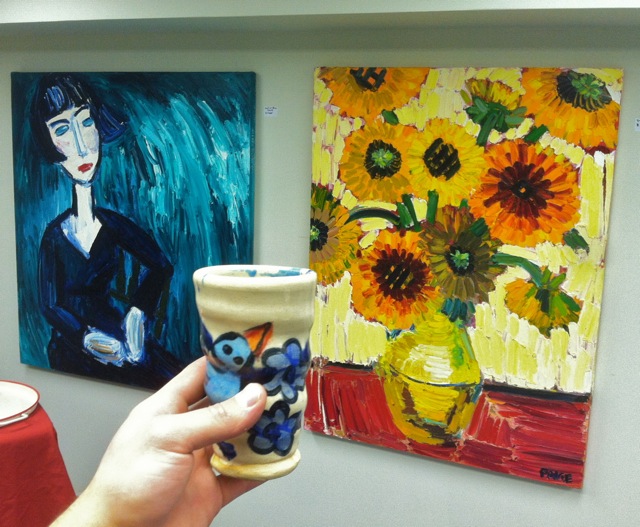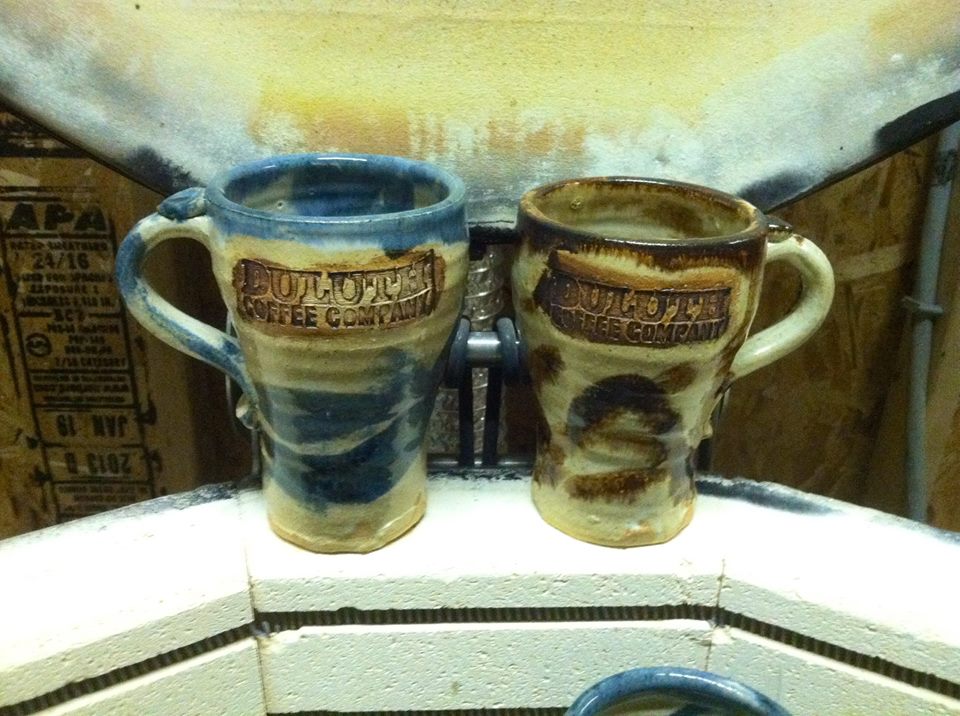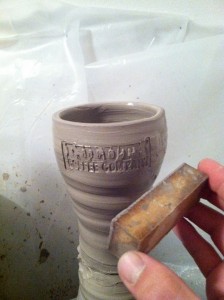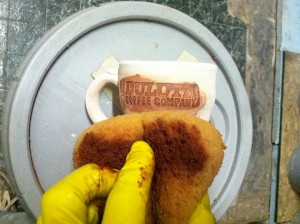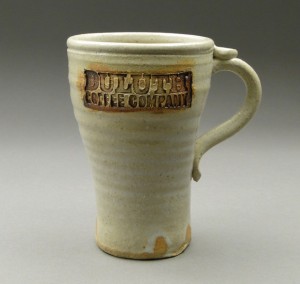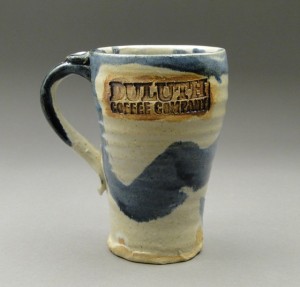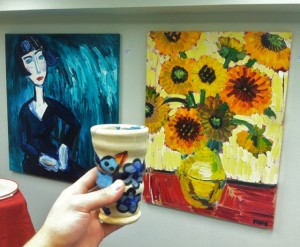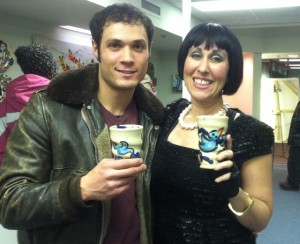This is the seventh post in a series entitled, “A Potter’s Journey” for American Craft Council’s website. This post tells the story of growing my pottery businesss with the help of a mutually beneficial partnership with a local coffee shop, the Local Blend:
Cosmic Pots: The “Goldilocks Glaze”
Thirty-four years ago, astronomer and Cosmos host Carl Sagan made his famous claim:
“If you wish to make an apple pie from scratch, you must first invent the universe.” – Carl Sagan. “The Lives of the Stars.” Cosmos: A Personal Voyage. PBS. 1980.
Sagan could have been talking about making anything from scratch. His goal was to convey that everything on earth, everything in the universe, is made up of precise combinations of the most basic elements, and those elements were created in stars’ nuclear cores. We could also say, “If you wish to make a pot from scratch, you must first invent the universe.”
These star-forged elements combine to form all the components of ceramics: the different strains of clay (silicon and iron), the water used in throwing (oxygen and hydrogen), the arboreal ingredients of glazes (calcium), and even the potter himself (carbon). Entire books could be written focusing solely on one of these ceramic elements.
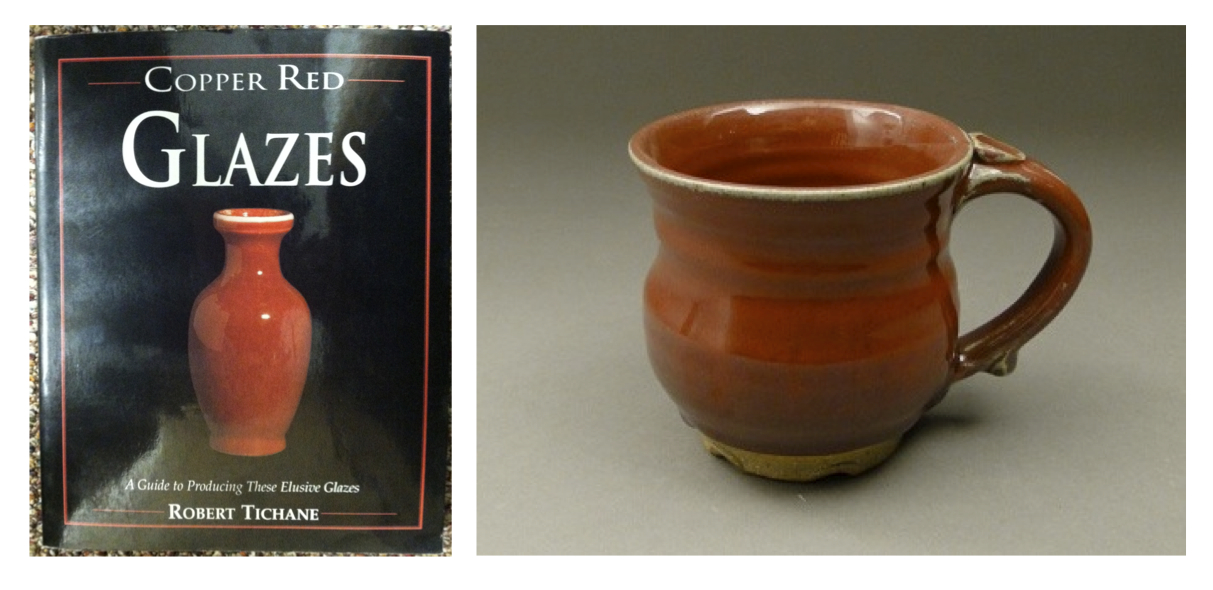 Copper, for example. Copper red glazes have been meticulously pursued and produced since the fifteenth century in China. The new host of Cosmos, Neil deGrasse Tyson, often analyzes the concept of a “Goldilocks planet” – a planet which has the precise conditions for possibly sustaining life. A successful copper red glaze is a “Goldilocks glaze.” Everything in both the recipe and the firing must be perfect.
Copper, for example. Copper red glazes have been meticulously pursued and produced since the fifteenth century in China. The new host of Cosmos, Neil deGrasse Tyson, often analyzes the concept of a “Goldilocks planet” – a planet which has the precise conditions for possibly sustaining life. A successful copper red glaze is a “Goldilocks glaze.” Everything in both the recipe and the firing must be perfect.
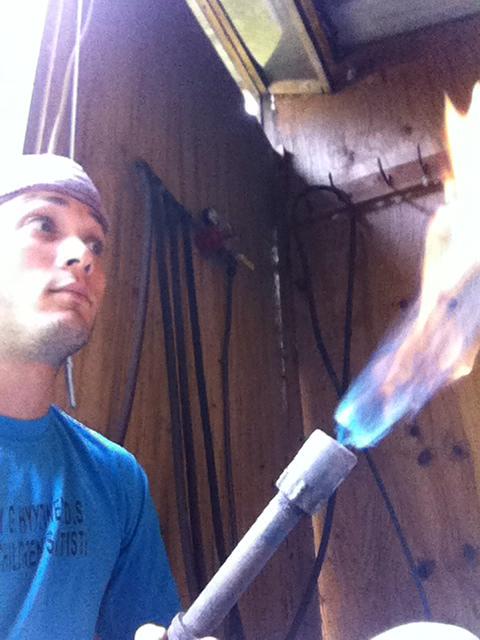
As Sagan and Tyson have taught us, science is found in everything we do. Baking an apple pie from scratch, developing a new drug, and mixing and firing glazes all rely on experimentation, creativity, and chemical reactions. A potter doesn’t need a degree in chemistry, but he uses some pretty cool science to produce copper red glazes.
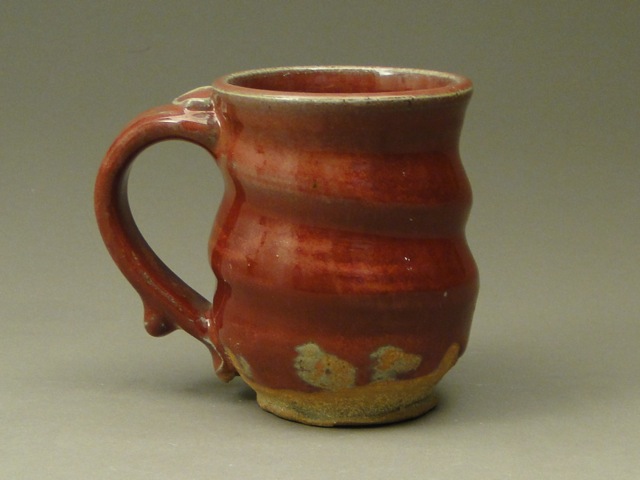 Nowadays, gas-fired kilns produce the best conditions for copper red glazes, but ancient Chinese potters created their beautiful pieces using only wood-fired kilns. Many potters do not have regular access to gas- or wood-fired kilns, and use electric ones instead. Electric kilns eliminate the need for constant temperature monitoring, but they are unable to create the atmosphere copper red glazes require.
Nowadays, gas-fired kilns produce the best conditions for copper red glazes, but ancient Chinese potters created their beautiful pieces using only wood-fired kilns. Many potters do not have regular access to gas- or wood-fired kilns, and use electric ones instead. Electric kilns eliminate the need for constant temperature monitoring, but they are unable to create the atmosphere copper red glazes require.
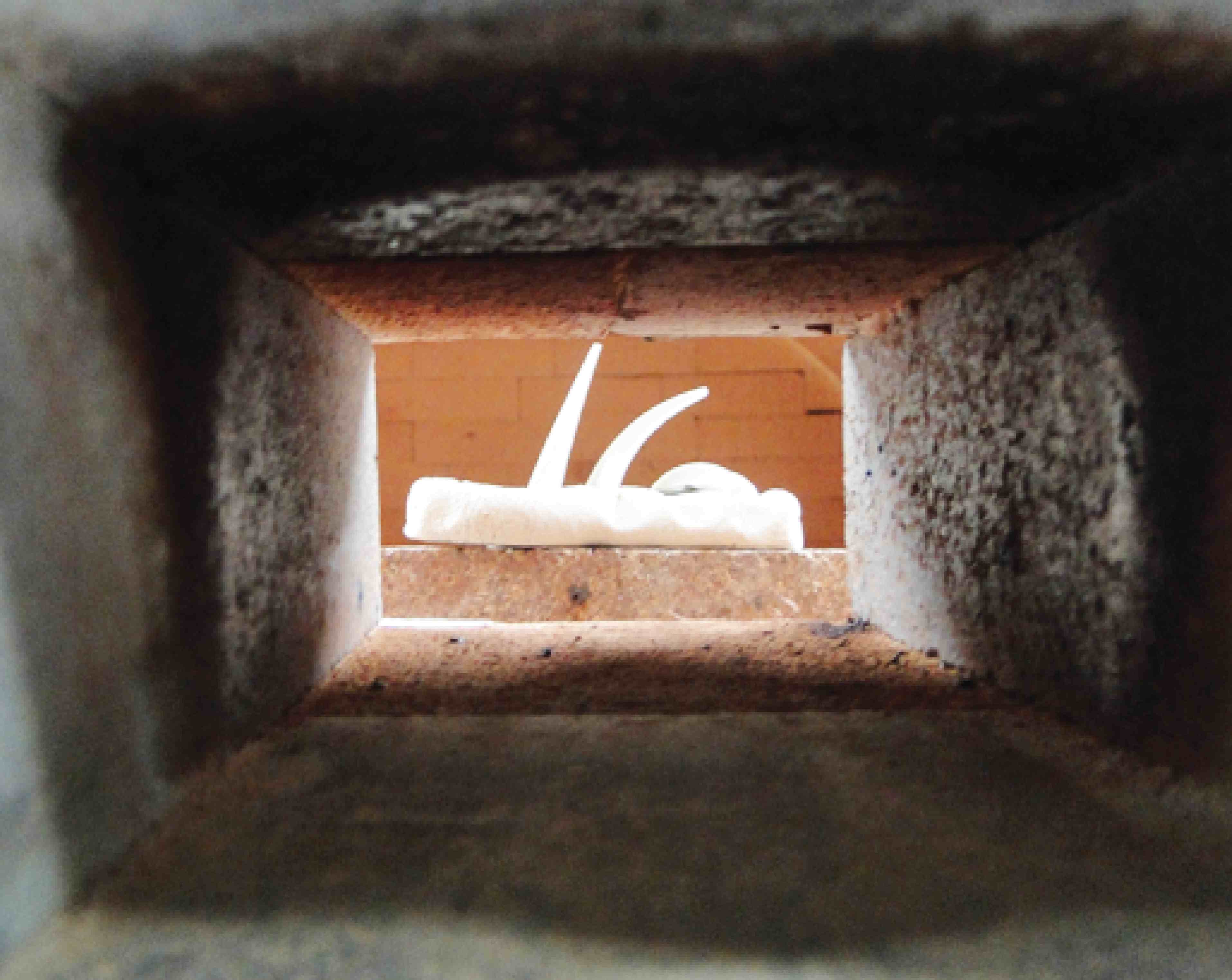
Copper red glazes need to be fired to a temperature called “cone 10.” This photo shows three cones (small pieces of clay), set up inside a gas-fired kiln. Each of these pieces is made from a different factory-produced type of clay formulated to melt at a certain temperature. A device called a pyrometer can be used to measure the temperature of the air inside the kiln, but what really matters is the temperature of the clay, hence the use of cones. When cone 10 melts, the potter knows the clay is roughly 2345 °F.
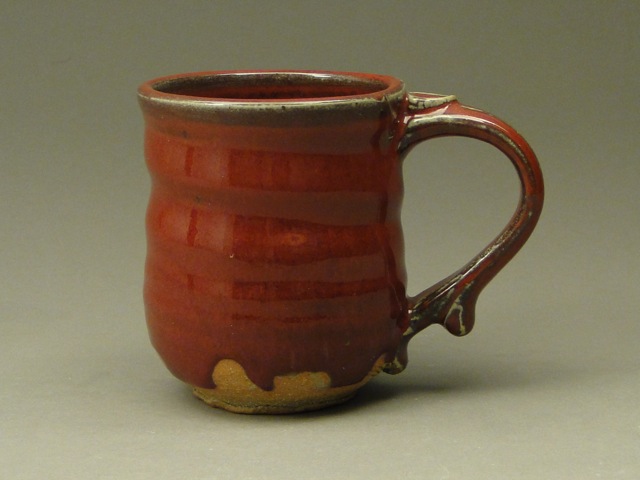 Even inside the same kiln, the atmosphere unavoidably varies. The pots below all had the same glaze and firing, but were placed in different areas of the kiln.
Even inside the same kiln, the atmosphere unavoidably varies. The pots below all had the same glaze and firing, but were placed in different areas of the kiln.
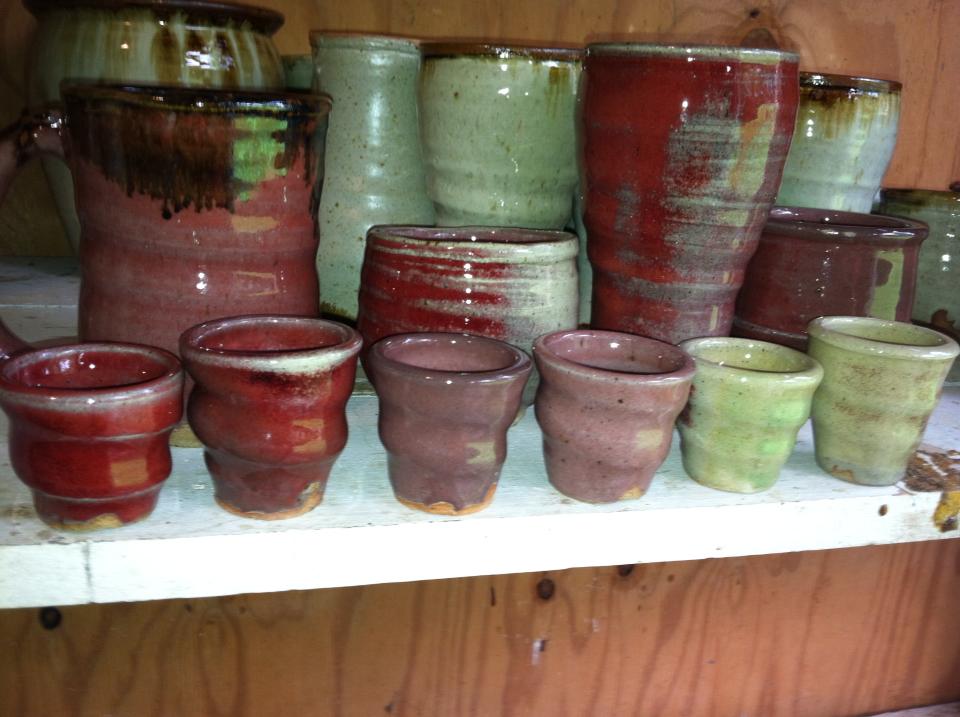 The green color on the right also occurs when firing a copper glaze in an electric kiln.
The green color on the right also occurs when firing a copper glaze in an electric kiln.
Color, just like copper, depends on the stars. Light from our sun strikes objects on earth, and those objects absorb some wavelengths of light and reflect others. The wavelengths they reflect are the colors we see. As Tyson puts it:
“Color is the way our eyes perceive how energetic light waves are.” – Neil Degrasse Tyson. “Hiding in the Light.” Cosmos: A Spacetime Odyssey. Fox. 2014.
Thankfully, potters did not have to create the universe to make pots from scratch. Their ingredients are already present in the cosmos, swirling in the air and lurking in the earth, waiting for them.

Finding a Balance in an Imbalanced Art World
Hannah Anderson worked as a “Pottery Marketing Intern” this semester. She is a senior Art major at the College of St. Benedict/St. John’s University. In this post, she describes our semester long task of trying to define the role of pottery in the contemporary art world.
Guest Posting by Hannah Anderson (view her Linkedin page here)
Throughout my internship with Joel, we had many discussions of “high art” vs. “low art” and where his pottery fit into the mix. High art, one could argue, is not functional for the consumer. Traditionally, the function for this type of art is to sit in a museum as a masterpiece, observed through this elevated status. Low art is generally mass-produced, inexpensive, and far more available to the public. In my critical theory class, we discussed how museums have opinions on high and low art as well, and can influence how people view artwork by either appearing intimidating or more approachable.
The terms “high” and “low” art should be reevaluated and adapted to today’s contemporary art world. Words that correlate with high art seem far too Renaissance or Baroque in feel, such as “master of art,” prestige, traditional, western, still-life, landscapes, portraits, and, my favorite, original. This particular word poses the question: can high art even exist anymore? I would argue that it certainly still exists, but not in the same light in which it was originally established. High art and low art should be adaptable terms for each new generation of artists. Low art has synonyms such as: consumerism, production, affordable, advertised, ordinary, etc. This is a challenge many artists face today, and it creates a huge imbalance in the art world.
Joel poses the question, “why are we making and selling pots?” He gathers a lot of insight from potter Warren Mackenzie, whom also has a lot to say about art as a functional vessel vs. sitting in a gallery space. Warren is an 89 year old, world-renowned artist. He is most at ease with his work when he knows it is being used, handled everyday and looked at often. Pottery has the potential to be the most intimate of artwork, because it’s users have constant contact with it. Clay is not expensive and is made from the earth, so when does it make the transition from low to high art?
Price plays a factor into what is high and low art. Warren says “A 10 dollar pot, now that’s affordable.” He says that if it breaks, then it is not a huge loss. This is interesting coming from a renowned artist, because his philosophy conflicts with his position in the art world; his pots resell on Ebay.com for hundreds of dollars everyday. Mackenzie says, “Unfortunately, now I only sell through galleries.” His philosophy seems more focused on low art, but his standing is high.
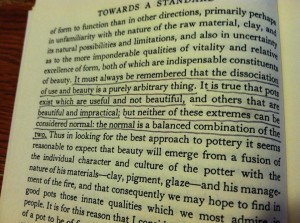
I like to think that many artists in today’s art world present a mix of high and low art, and it is perhaps just difficult to find the balance. Right now, an imbalance is evident in Joel’s artwork. His pottery is functional, consumer-friendly, priced lower than most professional potters, and is meant to bring a comfortable aesthetic to anyone’s home. His online store is in contrast with this idea, because we take a high art approach by using professional photography equipment to shoot pots in front of a gradated background. We then use these photos to try and join the contemporary art world.
I wonder, is the Local Blend pottery high or low art? At the Local Blend coffee shop, they use Joel’s pottery in mass, so anyone can eat and drink from his pottery everyday. This seems much closer to low art to me. We take the same pots and put them in front of a gradated background, making them high art in a different atmosphere. Without a little low art, high art wouldn’t be possible, since the Blend is where most of Joel’s income is generated. Writing about this venue has also brought him some of his biggest successes in the art world, including 2 major magazine publications. Perhaps these everyday pots will someday be elevated to a high art status?
Low art is what’s paying the bills, yet in the future, Joel wants to support his livelihood with a balance between low and high art. This means more of his income needs to be generated from our work on the online store. One way we accomplished this was by branding his artwork in a more focused way, using one glaze: the Nuka Glaze with iron. Nuka with iron had a great deal of success for Joel throughout my internship, enough for him to narrow his focus toward solely that glaze. Currently the online store has less Nuka with Iron than Joel would like, and his future plans are to recreate his online store geared toward pottery of only that glaze type. Over 50% of the online sales were Nuka with iron, and Joel sold pots with this glaze type to five different people both locally and nationally in one week. He has also completed 4 dinnerware sets in this glaze, 2 of which were sold through wedding registries. We see huge potential in this glaze combination.
This branding was influenced by Ayumi Horie, who certainly has a recognized, established, successful brand for herself. Her style is easily recognizable on every pot. Her artwork sells at high prices online and is always sold out in less than a day. Moreover, Horie has earned her place in the art world through years of consistent craftsmanship, a huge resume, and skillfully writing about her craft in major publications.
Our experience with high art continued through Paige Dansinger– an internationally renowned painter and art historian who is collaborating with Joel. She makes high art in the form of painting on canvas, digital paintings on IPads, projections, performance, and most recently, painting with glazes on Joel’s pottery. During my internship, she opened a gallery in the Minneapolis Skyway Mall called Gallery Paige. Everyday, she exhibits and sells her artwork as high art. The collaborative work made by herself and Joel has huge potential to take off in the high art world.
To conclude, perhaps in today’s world, the balance needs to be found in the middle of the spectrum between high art and low art. Are the best artists those who spend their time making both high and low art? One could argue that they can reach the most amount of people that way. Because that in fact is what art is all about: reaching the most amount of people with a particular message. The meaning of art and its purpose to be seen can easily get lost when identifying it as either high or low. As renowned potter Bernard Leach said, “To me the greatest thing is to live beauty in our daily life and to crowd every moment with things of beauty. It is then, and then only, that the art of the people as a whole is endowed with its richest significance.”
Pottery Business Trip: Stamped Mugs for Duluth Coffee Company, Artist Dinnerware for Gallery Paige
“When asked about his chief concern as an artist and potter, he modestly replied, ‘I honestly do not know. I respond to something inside me and I do not know what I am doing until I have done it. The moment of completion is sharing with others. The work is from myself but not for myself.’”
– Jonathan L. Fairbanks, about Brother Thomas, October 2007, from “Remembering Brother Thomas Bezanson,” Pucker Gallery, Boston.
The moment of completion is an exciting part of the pottery process. My old college professor, Sam Johnson, used to say that unloading glaze kilns was like Christmas or Halloween. Either the pots turn out great and cause an adrenaline rush of excitement, or ugly, flawed glazes send you plunging into a pit of despair.
When good pots do come out of the kiln, the artistic process continues to the viewer or user of those pots. Brother Thomas created forms and surfaces with inherent beauty, and he knew that this beauty needed to be shared. His work is exhibited in museums and galleries across the world. Sharing artwork lets artists grow by collecting feedback from viewers. Potters generally do this in 2 ways: exhibition and sales.
I see a lot of common ground between good kiln openings, selling pots, and exhibiting art. They involve the culmination of hard work and reaping rewards. The experiences happen quickly and often bring good vibes that linger for hours. Last Friday, I shared three of these experiences in one, epic day. It’s also worth mentioning 381 miles of travel, which comes to $215 in tax deductions at $.565 per mile according to www.irs.gov.
8:00am Kiln Opening
I opened the Skutt kiln and pulled out about 70 mugs for Duluth Coffee Company, made with a hand carved stamp by Bruno Press. I spent an hour polishing the bottoms of 100 total mugs, packaged them in 5 clay boxes and loaded the car. After a morning of errands, I drove from St. Joseph to Duluth.
2:00pm Duluth Coffee Company Drop-off
Eric Faust, owner and roaster, met me with an awesome cup of fresh roasted coffee and a check. This was an order for re-sale, and it could revolutionize how I make new bodies of work for coffee shops. Last year, Eric worked with a potter that sold about 400 stamped mugs through his shop. The potter moved out of state and Eric has been searching for a potter to rejuvenate this project. I was lucky enough to meet him months ago, when visiting friends in Duluth and scouting coffee shops. I was even luckier when he offered to buy the mugs wholesale- the first time this has happen in my 3.5 years as a full-time potter.
Eric generously let me retain artistic freedom. Too often I have received requests for stamps, carvings, or colors that fall outside my aesthetic interests or capabilities. This project reflects Duluth Coffee Company’s philosophies about roasting and brewing signature, gourmet coffees for the local community.
8:00pm: Gallery Paige, Grand Opening
Paige Dansinger is a renowned painter and art historian who has exhibited internationally, including a show at the Guggenheim this past spring. We met coincidentally at Continental Clay supplier while she was buying machine-made plates and glazes to paint for a commission. I said, “It would be great if a potter could make plates for you” and she replied, “Well, do you make plates?” Also coincidentally, I was at Up Cafe performing pottery throwing demos, that day only. She saw me throw, saw the stack of 500+ pots in their space, and we caught the vibe that we need to team up.
In the 2 months I’ve known Paige, she’s come to my kiln space to paint on my pots, invited me to her studio to view her process and bring more pots, and opened a gallery. That’s right, she opened a gallery in the downtown Minneapolis Skyway mall!
Gallery Paige had the Grand Opening Friday. Dozens of her pieces graced the gallery walls as paint on canvas, painted plates, and her innovative #DrawArt displayed as video and projection. Artists and art collectors streamed in and out of the space for hours. I brought her the first 2 glazed, finished pots from our collaboration and we shared a toast to the next body of work! Her paintings are gorgeous and I feel honored to begin the process of making pots as canvases for such a renowned artist.
When I met Paige she said, “I want my paintings in museums all over the world, hanging next to Picasso.” I think she’s on track to live into that goal!
Photo by Paige Dansinger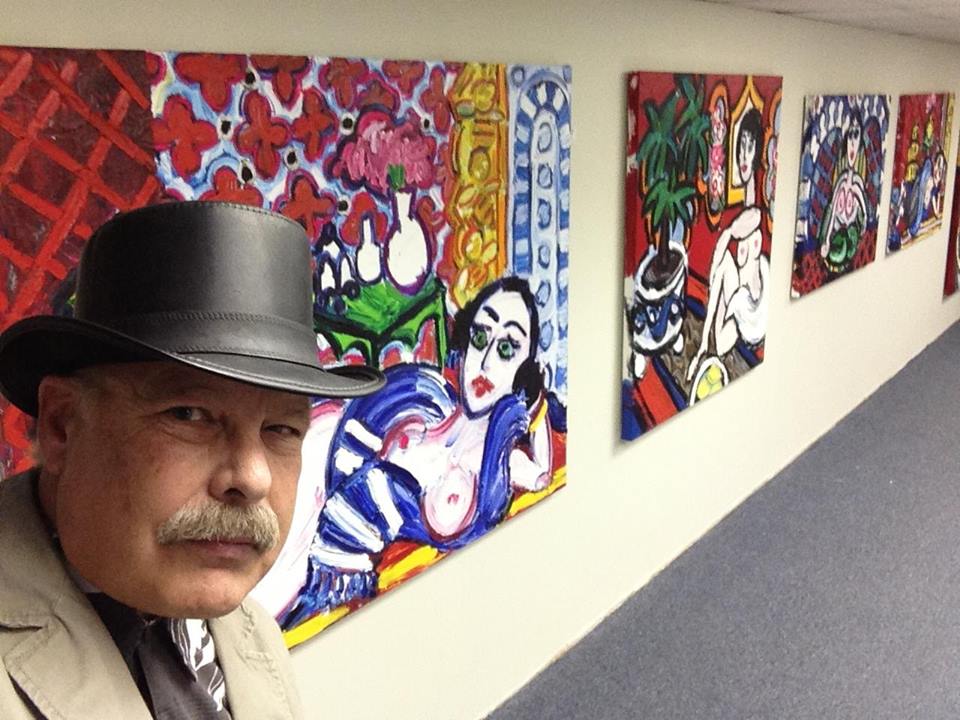
Photo by video artist Jim Mcallister. View some of our collaborative work here:
New Pots at Up Cafe: Customers Using Handmade Pottery Everyday
Over the month of December I busted out about 550 new pieces of pottery for use as serving vessels in Up Cafe– a new coffee shop in northeast Minneapolis! This new coffee shop is attached to Upper Midwest Gourmet and Flamenco Organic Coffee Roastry. They’re open for business, so you can stop by anytime and sip an artfully mixed coffee drink from one of my mugs. Check out this spread in Minnesota Monthly about their “soft opening”
Below are a few images of my pottery in their space. Watch for future posts of higher quality images and information about their grand opening. Also, special thanks goes out to my cousin Michael Applen for his Entrepreneurial mindset. He always pushed me to come up with new ways to get my pottery out into the world. He was an important part of getting pottery into Up Cafe, as well as getting this coffee shop open for business. Thanks for your help cous!
Also thanks to Central Minnesota Arts Board for awarding me a $3,000 grant that helped make this possible!
[wppa type=”slideonly” album=”9″][/wppa]
